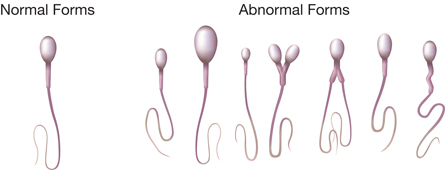Module 3
1. Module 3
1.14. Page 4
Module 3—The Male and Female Reproductive Systems
 Reflect and Connect
Reflect and Connect
Update: A Fertility Case Study
Think back to José and the semen analysis test he underwent. From your new knowledge of how supporting structures help gametes develop, you can better understand how a semen analysis can contribute to diagnosing an infertility problem.
A semen sample must be analyzed within two hours of being collected. Lab technicians analyze the sample for the following traits:
- volume: Low volume might suggest an anatomical or functional defect.
- motility: The quality of spermatozoa movement needs to be forward and progressive, and 40% to 60% of the spermatozoa need to be motile.
- count: A count below 20 million/mL could indicate sterility.
- pH: An increase in the sperm's pH above the normal slightly alkaline state could indicate an inflammation of the prostate.
- fructose: Absence of this sugar may indicate a possible obstruction of the ejaculatory ducts or seminal vesicles.
- morphology (size and shape): Only 35% or less of the sperm should have some type of abnormal structure, as seen in the following image.

oligospermia (oligozoospermia): a condition in which there are less than 20 million spermatozoa per millilitre of semen
José’s sperm analysis showed a low sperm count. The medical term for this is oligospermia. If you were José’s fertility physician, you might have considered prescribing a drug called clomiphene, which is sold under the name Clomid.
 Reflect on the Big Picture
Reflect on the Big Picture
Understanding how the structures that support the egg and sperm develop properly functioning gametes is essential to understanding the functions of the male and female reproductive systems.
Continue to make notes about the couples’ fertility problems, specifically those of José. Do an Internet search to learn more about oligospermia and the drug Clomid. Save your notes, including conclusions or assumptions, in your course folder. Remember that information and questions about the couples’ fertility issues will be referred to throughout Unit B and will be part of the Unit B Assessment.
 Going Beyond
Going Beyond
corpus luteum: the structure that develops from a matured follicle that has released its egg
The corpus luteum produces progesterone and some estrogen. If pregnancy does not occur, the corpus luteum degenerates.
You have been introduced to several disorders in the first three lessons of Module 3. Can you find disorders that are specifically related to the supporting structures like the Sertoli cells, interstitial cells, primary or secondary follicles, and corpus luteum?
 Module 3: Lesson 3 Assignment
Module 3: Lesson 3 Assignment
Submit your completed Module 3: Lesson 3 Assignment to your teacher for assessment.